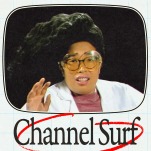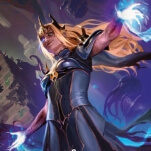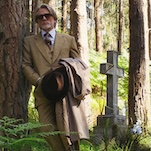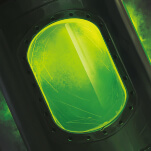French comics scribe Fabien Vehlmann continues his run of penning a slate of varied and interesting comics, highlighted by the quality of his artistic collaborators. In The Marquis Of Anaon: The Isle Of Brac, U.K. publishers Cinebook bring to English-language audiences the first book in Vehlmann and Matthieu Bonhomme’s five-volume series following eponymous hero Jean-Baptiste Poulain. Nicknamed “the marquis of lost souls,” Jean-Baptiste travels to places where strange and mysterious phenomena have been observed, investigating inexplicable, seemingly supernatural happenings, with the aim of both assisting people and enriching his scientific knowledge.
Published in French in 2001, this opening volume is decidedly gothic in tone and influence, yet also admirably restrained. Jean-Baptiste arrives on the Isle Of Brac, where he’s been hired to tutor the young son of Baron Gwenole. Things are amiss even before he sets foot on shore: His fellow passengers cower and shun him at the mention of the Baron’s name, and upon docking, the island inhabitants are similarly fearful and suspicious. Events take a darker turn once Jean-Baptiste reaches the Baron’s house; his son, Nolwenn, is missing. At first presumed to be on one of his regular wanderings, tension between the Baron and the close island community mounts to dangerous heights when Nolwenn is found dead. Jean-Baptiste’s tenure seems at an end before it began, and he’s eager to get off this strange rock with its foreboding moors and unwelcoming people, but no escape is to be had due to an onslaught of rough and choppy weather.
The aforementioned restraint is immeasurably aided by Bonhomme’s quietly beautiful art, which layers in mood and atmosphere, made all the more appreciable thanks to Cinebook’s commitment to publishing French translations at their original, large-format size. Bonhomme’s style falls somewhere between the atomic and ligne claire styles, for the most part alternating between fine lines and the use of a thicker—but not too heavy—black line that provides greater visual pop and effect, but with texture and shadow used to lend emotional weight, conjuring dread and horror. He has a distinct way of drawing faces: varying shapes and sizes with an emphasis on the brow, and a real consideration of individual character. Colorist Delf keenly attunes his colors to the brooding ambiance—dark greens, grays, purples, and blues mirror the story. Amid all this, Jean-Baptiste is set apart, quickly distinguished by the poppy red of his coat, which provides a symbol of difference, in mindset and in thought.
Finding himself stuck on Brac, Jean-Baptiste can’t help but be curious about what has occurred, and attempts to sift through what happened to gauge what is rumor or misunderstanding, and what is rooted in something more substantial. He and the reader seesaw back and forth in siding with one party and then another, and believing the legitimacy of each’s arguments. His struggle for the truth behind Nolwenn’s death presents the classic gothic juxtaposition of science and reason versus traditional beliefs, and further: that which is beyond the explanations of man. Vehlmann and Bonhomme deliver an assured, grounded, and stylish tale that sets Jean-Baptiste nicely on course for further adventures. [Zainab Akhtar]
Sam Alden is a familiar name, even if the style of
Lydian (Space Face Books) is far from familiar. Alden is the creator responsible for last year’s
Wicked Chicken Queen, which
we reviewed favorably before placing the minicomic on our
best of the year list. As singular as
Wicked Chicken Queen is,
Lydian is completely different, and it’s still quite rewarding.
Lydian is a 6-by-6-inch square-bound book with a candy-colored cover and full color insides. The square shape is no happenstance: The entire book is rendered in blocky pixel art, abstracted almost to the point of illegibility. It’s less even than 8-bit, more reminiscent of the primitive 4-bit of early Atari systems. The narrative is similarly abstract. The book is structured as a series of vignettes, and Lydian’s story is consequentially fragmented—flashbacks and reveries occur at regular intervals.
The main plot, such as it is, features Lydian organizing a war party to fight Clyde, the sentient tropical resort, a roughly phallic-shaped white-and-black structure in the middle of the ocean. (Clyde’s cronies are Alec the sentient lighthouse, Garth the sentient cabana, and Lars the sentient casino.) The members of Lydian’s party are all presented as either female or female-identifying—Jane, X-Beam, Earth (the good-looking one), and Lynda (Lydian’s mom). The visual metaphor isn’t hard to grasp (ahem). Alec the lighthouse sends out beams of light from the top of a long, narrow tower. The first kind of beam empowers his allies while in the glare of the second beam, “strong and cool people are made weak and trivial.” Boss fight ensues.
It would be a mistake, however, to imply that the book is the sum of its plot points. Lydian’s internal narrative occupies much of the book that isn’t concerned primarily with battling evil lighthouses. Lydian lives in fear of a mysterious red woman who haunts her and chases her through this lushly rendered pixelated world. Much of the book is given over to exploration, with Lydian wandering through different parts of the landscape in contemplation. The reader is left wondering whether Lydian is a native to this computerized land or an avatar for another person living in something that might resemble our “real” world, organizing online raids with friends and dispatching emails to nail down schedules. The strangest interlude occurs when Spyro The Dragon—yes, that Spyro—shows up for a few pages for the purpose of flying through a dark cavern.
As with Wicked Chicken Queen, there are very few immediate comparisons that jump to mind regarding Lydian. It’s a memorable and, at times, beautiful book that does not compromise in asking the reader to surrender to its own peculiar rhythms. It’s the kind of book that might not seem like it takes long to finish, but which you’ll find yourself picking up again and again, flipping through the pages and revisiting each scene in turn. [Tim O’Neil]
Any time a new set of #1s comes out, there’s bound to be some hits and some misses. Books that are just starting out can take a few issues to find their rhythm, or for readers to find them. It can be hard to judge anything based on the first couple dozen pages of what could be a run that lasts for years, but sometimes it’s easy.
David F. Walker, who’s work on
Shaft for Dynamite has earned him a well-deserved reputation for excellence, starts things off with a bang in
Cyborg #1 (DC). Without missing a beat, Walker navigates the reader through Victor Stone’s backstory and his relationship with his father and the body that Silas Stone put him in.
Cyborg has years of continuity to own up to thanks to
Justice League, but the shift from an often underused part of a team to the head of a solo book is nearly seamless thanks to stellar character work. By the end of the issue it’s clear who the big players are, and what they’re motivated by. Each relationship is allowed room for nuance and growth, impossible when Cyborg was backup for the rest of the League instead of his own man. It comes as no surprise that Walker shows more sides of Vic than readers have seen in a long time; he jokes wryly about his own death, but is also allowed moments of softness and sharp anger that quickly burns away. There’s more emotional depth and breadth for the main character in this first issue than some writers can manage in a whole run. Walker’s just that good at capturing the humanity of this more-than-human man.
It certainly doesn’t hurt that Walker has penciler Ivan Reis, inker Joe Prado, and colorist Adriano Lucas working with him. It would be significantly more difficult to convey all that emotion if Reis and Prado didn’t excel at subtly distinct facial expressions. Particularly since they’ve only got about two-thirds of a face to work with when it comes to Vic, it would be easy to rely exclusively on lettering and body language to make sure the reader knew what was going on. But Vic and his supporting cast of characters are demonstrative and dynamic. The talent on Cyborg could easily support any well-established book, so it’s gratifying to see this level of detail and design work on a character that’s been underserved in the past. It reminds the reader that Vic isn’t just a member of a team—he’s a colleague of Batman and Wonder Woman, just as capable and necessary.
The best parts of this book are the glimpses into Vic’s life outside of being Cyborg. For the last few years he’s been shouldering a lot of weight that he didn’t necessarily sign up for, between the Justice League and other teams calling on him for help. But in Cyborg #1 we see that for all he might be called a superhero, and for all that he might look like a machine, Vic is a young man, and more specifically, a young black man with a disability. There’s a lot to unpack there, and a lot of different identities he has to adopt and code switch between. The unfortunate side effect is that the plot-focused pages, where aliens build toward an impending threat, are significantly less interesting than those that are character focused. Judging by Walker’s work on Shaft, that won’t be a concern for long: He’s got a knack for delivering complicated and intriguing stories that are a joy to unravel. This is one of the best new #1s to come out of the DC You initiative, hands down. [Caitlin Rosberg]
The legend of Heracles (or Hercules) is well-trodden territory in pop culture. It’s been the subject of movies and television shows, with two different Heracles films appearing in theaters last year, and the character has shown up in enough books and comics over the years that many readers are likely to be familiar with his tale. But because of its mythical foundation, Heracles’ narrative is extremely malleable to fit whatever message the storyteller wants to get across. In
The Hero: Book One (Dark Horse), David Rubín uses Heracles’ story to explore duty, fate, celebrity, and jealousy, emphasizing the relationship between Heracles and King Eursytheus, who has been given a mission by the goddess Hera to kill the bastard son of her husband Zeus.
In Rubín’s interpretation, newly translated by Katie LaBarbera from the 2011 Spanish edition, fate has decreed that Heracles would live his life in service to Eurystheus, and a major element of this first book is Heracles learning to take control of his destiny. As he performs the labors that are intended to kill him—depicted in dynamic, powerful action sequences by Rubín—he gains fame and notoriety in the community, forcing him to negotiate his increasing profile and sense of self-worth with his predestined obligation to the monarch that uses him as a slave. It’s a story that is equally epic and intimate, balancing moments of intense action with more introspective storytelling that makes Heracles an especially engaging lead.
The Hero actually shares a lot of similarities with Disney’s Hercules movie, from the cartoonishly exaggerated art style to the ways Rubín uses Heracles to comment on the nature of celebrity in modern times. But unlike Disney’s adaptation, Rubín’s vision is intended for mature readers. Rubín embraces the erotic in his work, with an early scene showing Heracles’ first sexual encounter with an Amazon named Diana who uses her magic lasso to tie the teenage hero up for some bondage play. Diana is one of the ways that Rubín incorporates American superheroes into his story, and the climax of the issue uses Superman imagery in a hallucinogenic sequence that see Heracles finally finding pride in himself. It’s a clever way of exploring Heracles as an early superhero figure, using the history of the medium to enlighten a story far older than comics.
Rubín’s story isn’t set in ancient Greece, but a contemporary environment that is a fusion of those classical Greek elements, Jack Kirby-esque superhero design, and contemporary flourishes like an iPod that Heracles uses to play David Bowie’s “Heroes” during one of his labors. That combination gives the book a distinct style, and the visuals only become more captivating as Rubín experiments with his rendering and composition in the final scenes. The legend of Heracles may be thousands of years old, but in Rubín’s hands, the story feels fresh and new. [Oliver Sava]








































